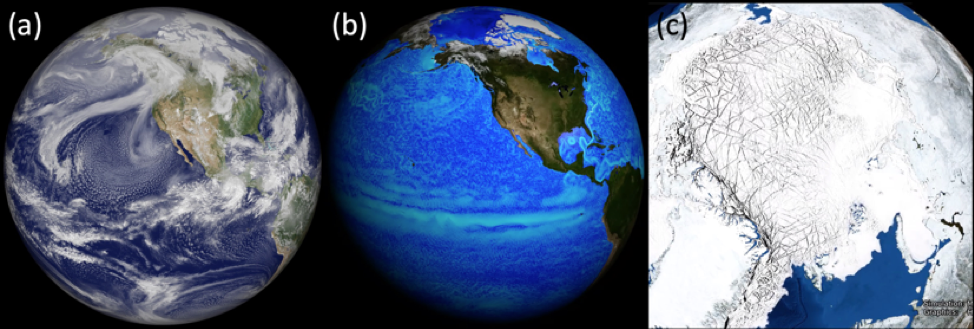Scientists Run Coupled Atmosphere-Ocean Simulations
at Groundbreaking Resolutions on NASA Supercomputers
at Groundbreaking Resolutions on NASA Supercomputers
NASA and university scientists are running simulations at groundbreaking resolutions with a new coupled atmosphere-ocean model combining the NASA Goddard Earth Observing System (GEOS) atmospheric model and a configuration of the Massachusetts Institute of Technology general circulation ocean model (MITgcm) from the Estimating the Circulation and Climate of the Ocean (ECCO) project. The two models are combined using the Earth System Modeling Framework (ESMF).
Flagship data-assimilating NASA models used in this study capture atmospheric and oceanic phenomena as varied as (a) clouds and aerosols from a cloud-resolving Goddard Earth Observing System (GEOS) simulation, (b) sea surface speed from an internal-wave-admitting Estimating the Circulation and Climate of the Ocean (ECCO) simulation, and (c) Arctic sea ice concentration and thickness from the same ECCO simulation. The coupled-model study is advancing NASA capabilities for seamless weather and climate simulation, estimation, and prediction by combining data assimilation expertise from the GEOS and ECCO teams.
A coupled model allows the atmosphere and ocean to exchange information as in the real world and capture air-sea interactions with greater fidelity. United with the processing power of NASA supercomputers, the coupled GEOS/ECCO model is enabling a study probing how swirls of ocean water called eddies affect circulation of both the ocean and the atmosphere.
Eddies represent a major pathway for transferring heat from the ocean to the atmosphere. Growing evidence shows eddies having remote impacts on wintertime European blocking (causing anomalously cold and dry weather), monsoon rainfall, and rainfall along the U.S. North Pacific Coast.

Model resolution must be high enough to resolve the eddies. In addition to a standard spatial resolution of 1-degree in both ocean and atmosphere, the scientists are running two high-resolution configurations: 1) 1/12-degree ocean and 1/8-degree atmosphere and 2) 1/24-degree ocean and 1/16-degree atmosphere. (Note: At the equator, a degree of latitude or longitude equals approximately 111 kilometers, or just under 70 miles.)
These simulations run on the NASA Center for Climate Simulation (NCCS) Discover supercomputer and the NASA Advanced Supercomputing (NAS) Facility Pleiades supercomputer. Run times for the various simulations are as follows:
| Simulation Time Frame | Resolution | Number of Cores | Wall Clock Time |
|---|---|---|---|
| 10 years | 1-degree ocean and atmosphere | 360 | 10-15 days |
| 4 days | 1/12-degree ocean, 1/8-degree atmosphere | 2,880 | 1 day |
| 1 day | 1/24-degree ocean, 1/16-degree atmosphere | 7,794 (Pleiades-only) | 1 day |
Data needed to start and run the simulations comes from the MERRA-2 (run with GEOS at NCCS) and ECCOv4 (run with MITgcm at NAS) reanalysis products. Output data ranging from 10 to 100 terabytes per simulation gets stored on the Discover and Pleiades supercomputer disks.
An initial scientific analysis of the coupled-model output revealed 3-to-6-day oscillations of sea surface temperatures and surface wind anomalies. These oscillations appear in observational records and reanalyses but were previously unseen in ocean-only simulations. A paper describing these results has been submitted for review.
“NASA supercomputing is revolutionizing Earth science studies by enabling increasingly realistic simulations of the coupled ice-ocean-atmosphere system,” observed Dimitris Menemenlis, NASA Jet Propulsion Laboratory research scientist. “These simulations are guiding our understanding of coupled air-sea exchange processes and their parameterization in coarser-resolution weather and climate models. They are also guiding the utilization of existing satellite observations and the development of new instruments.”
Jarrett Cohen, NASA/Goddard Space Flight Center


